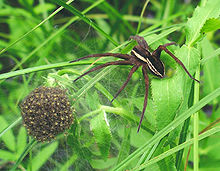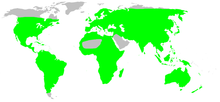Nursery web spider
| Nursery web spiders Temporal range:
| |
|---|---|

| |
| Nilus albocinctus, female Sabah, Borneo | |

| |
| Dolomedes fimbriatus with its nursery of babies | |
| Scientific classification | |
| Domain: | Eukaryota |
| Kingdom: | Animalia |
| Phylum: | Arthropoda |
| Subphylum: | Chelicerata |
| Class: | Arachnida |
| Order: | Araneae |
| Infraorder: | Araneomorphae |
| Family: | Pisauridae Simon, 1890 |
| Diversity | |
| 51 genera, 508 species | |

| |
Nursery web spiders (Pisauridae) is a family of araneomorph spiders first described by Eugène Simon in 1890.[1] They resemble wolf spiders (Lycosidae) except for several key differences. Wolf spiders have two very prominent eyes in addition to the other six, while a nursery web spider's eyes are all about the same size.[2] Additionally, female nursery web spiders carry their egg sacs with their jaws and pedipalps instead of attaching them to their spinnerets as wolf spiders do. When the eggs are about to hatch, a female spider builds a nursery "tent", places her egg sac inside, and stands guard outside, hence the family's common name. Like the wolf spiders, however, the nursery web spiders are roaming hunters that don't use webs for catching prey.
Species occur throughout the world except for extremely dry or cold environments, and are common just about everywhere. Many can walk on the surface of still bodies of water and may even dive beneath the surface temporarily to escape enemies. They can jump a distance of 5 to 6 inches (130 to 150 mm), but they have trouble climbing extremely smooth surfaces such as glass.
The name "nursery web spider" is especially given to the European species Pisaura mirabilis, but this family also includes fishing spiders and raft spiders. Adult specimens may reach up to 15mm in length, including legs. The legs of the male are longer in relation to body size than those of the female.[3]
The female spider sometimes attempts to eat the male after mating. The male, to reduce the risk of this, often presents the female with a gift such as a fly when approaching in the hope that this will satisfy her hunger. Sometimes, this gift is a fake present intended to fool the female.[4] Males may wrap the fake gift in silk, to deceive the female to mate. Females can detect the fake gift and terminate mating, negating the male's deception in not giving a real gift.[5]
Genera
As of April 2019[update], the World Spider Catalog accepts the following genera:[6]
- Afropisaura Blandin, 1976 —
- Archipirata Simon, 1898 — Turkmenistan, China
- Architis Simon, 1898 — South America, Trinidad, Panama
- Blandinia Tonini, Paulo da Silva, Serpa Filho & Freitas, 2016 — Madagascar
- Bradystichus Simon, 1884 — New Caledonia
- Caledomedes Raven & Hebron, 2018 — New Caledonia
- Caripetella Strand, 1928 — Madagascar, Comoros
- Charminus Thorell, 1899 — Africa
- Chiasmopes Pavesi, 1883 — Ethiopia, Namibia, South Africa
- Cispinilus Roewer, 1955 — Central Africa
- Cispius Simon, 1898 — South Africa, Congo
- Cladycnis Simon, 1898 — Canary Is.
- Conakrya Schmidt, 1956 — Guinea
- Dendrolycosa Doleschall, 1859 — Asia, Africa, Oceania
- Dolomedes Latreille, 1804 — Africa, Oceania, South America, North America, Asia, Cuba
- Eucamptopus Pocock, 1900 — India
- Euprosthenops Pocock, 1897 — Africa, India
- Euprosthenopsis Blandin, 1974 — Africa
- Hala Jocqué, 1994 — Madagascar
- Hygropoda Thorell, 1894 — Africa, Asia, Australia
- Ilipula Simon, 1903 — Vietnam
- Inola Davies, 1982 — Australia
- Mangromedes Raven, 2018 — Australia
- Maypacius Simon, 1898 — Africa
- Megadolomedes Davies & Raven, 1980 — Australia
- Nilus O. Pickard-Cambridge, 1876 — Asia, Africa
- Ornodolomedes Raven & Hebron, 2018 — Australia
- Papakula Strand, 1911 — Indonesia
- Paracladycnis Blandin, 1979 — Madagascar
- Perenethis L. Koch, 1878 — Asia, Comoros, Oceania
- Phalaeops Roewer, 1955 — Mozambique, Djibouti
- Pisaura Simon, 1886 — Asia
- Pisaurina Simon, 1898 — United States, Canada, Cuba
- Polyboea Thorell, 1895 — Asia
- Qianlingula Zhang, Zhu & Song, 2004
- Rothus Simon, 1898 — Israel, South Africa
- Sphedanus Thorell, 1877 — Singapore, Malaysia, Indonesia
- Stoliczka O. Pickard-Cambridge, 1885 — Pakistan
- Tallonia Simon, 1889 — Madagascar
- Tapinothele Simon, 1898 — Tanzania
- Tapinothelella Strand, 1909 — South Africa
- Tapinothelops Roewer, 1955 — Ethiopia
- Tasmomedes Raven, 2018 — Australia
- Tetragonophthalma Karsch, 1878 —
- Thalassiopsis Roewer, 1955 — Madagascar
- Thaumasia Perty, 1833 — Central America, South America, Mexico
- Tinus F. O. Pickard-Cambridge, 1901 — India, Cuba, North America, Central America
- Tolma Jocqué, 1994 — Madagascar
- Voraptipus Roewer, 1955 — Mozambique
- Vuattouxia Blandin, 1979 — Côte d'Ivoire
- Walrencea Blandin, 1979 — South Africa
Some fossilized spiders have also been assigned to this family:[7]
- †Eopisaurella Petrunkevitch, 1958 (Early Eocene; Baltic amber)
- †Palaeoperenethis Seldon & Penney, 2009 (Ypresian, British Columbia, Canada)
Gallery
-
Nursery web spider carrying egg sac
-
Megadolomedes australianus with a dragonfly as prey
See also
References
- ^ Simon, E. (1890). Etudes arachnologiques.
- ^ Sierwald, P. (1997). "Phylogenetic analysis of Pisaurine nursery web spiders, with revisions of Tetragonophthalma and Perenethis (Araneae, Lycosidae, Pisauridae)" (PDF). The Journal of Arachnology. 25: 361–407.
- ^ Anderson, Alissa G.; Hebets, Eileen A. (2016). "Benefits of size dimorphism and copulatory silk wrapping in the sexually cannibalistic nursery web spider, Pisaurina mira". Biology Letters. 12 (2): 20150957. doi:10.1098/rsbl.2015.0957. PMC 4780555. PMID 26911340.
- ^ Male Spiders Scam Females with Gift-Wrapped Garbage
- ^ Albo, Maria J; Winther, Gudrun; Tuni, Cristina; Toft, Søren; Bilde, Trine (2011-11-14). "Worthless donations: male deception and female counter play in a nuptial gift-giving spider". BMC Evolutionary Biology. 11 (1): 329. doi:10.1186/1471-2148-11-329. PMC 3228764. PMID 22082300.
{{cite journal}}: CS1 maint: unflagged free DOI (link) - ^ "Family: Pisauridae Simon, 1890". World Spider Catalog. Natural History Museum Bern. Retrieved 2019-04-23.
- ^ Dunlop, J.A.; Penney, D.; Jekel, D. (2015). "A summary list of fossil spiders and their relatives" (PDF). World Spider Catalog. Natural History Museum Bern. Retrieved 2016-03-15.


